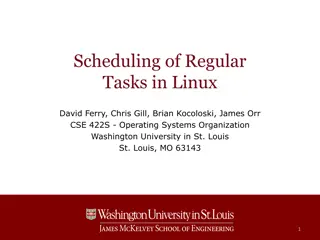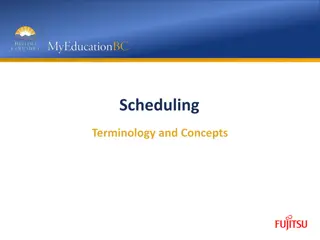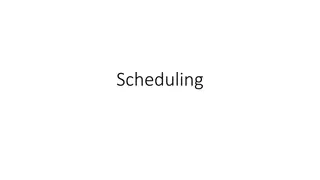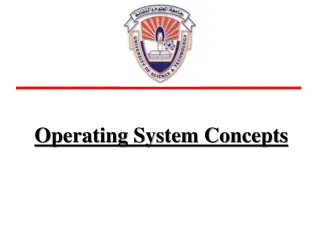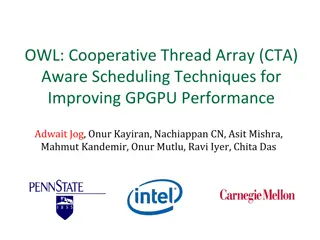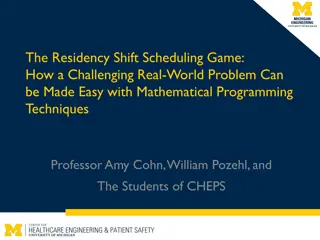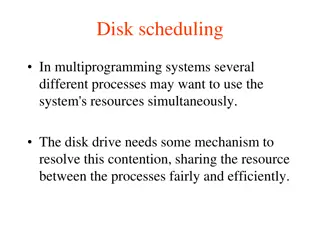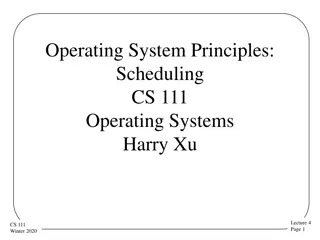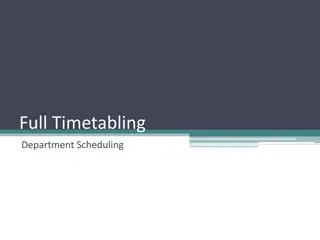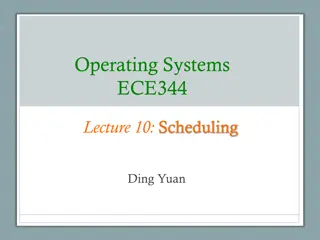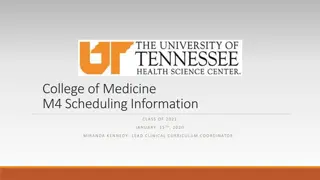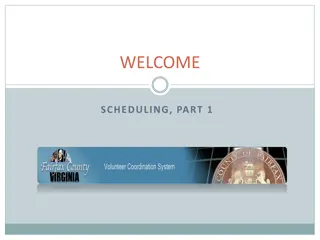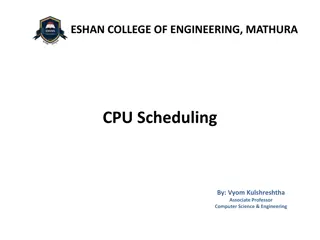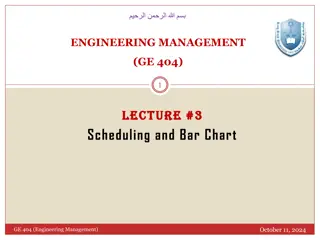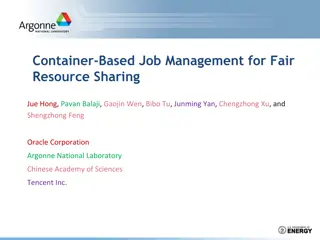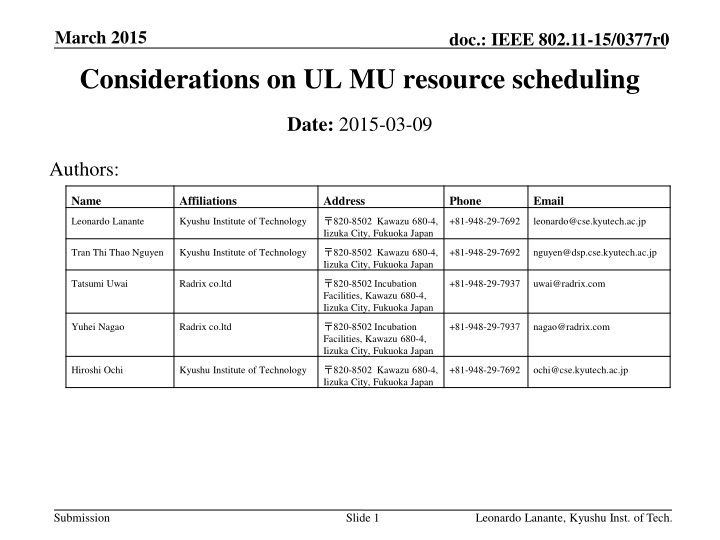
Considerations on UL MU Resource Scheduling in IEEE 802.11-15/0377r0
Explore considerations for UL MU resource scheduling in the IEEE 802.11 standard, particularly focusing on OFDMA transmission, subcarrier allocation, and performance implications with varying numbers of active STAs. The document discusses simulations and solutions to optimize OFDMA performance in multi-user scenarios.
Download Presentation

Please find below an Image/Link to download the presentation.
The content on the website is provided AS IS for your information and personal use only. It may not be sold, licensed, or shared on other websites without obtaining consent from the author. If you encounter any issues during the download, it is possible that the publisher has removed the file from their server.
You are allowed to download the files provided on this website for personal or commercial use, subject to the condition that they are used lawfully. All files are the property of their respective owners.
The content on the website is provided AS IS for your information and personal use only. It may not be sold, licensed, or shared on other websites without obtaining consent from the author.
E N D
Presentation Transcript
March 2015 doc.: IEEE 802.11-15/0377r0 Considerations on UL MU resource scheduling Date: 2015-03-09 Authors: Name Affiliations Address Phone Email Leonardo Lanante Kyushu Institute of Technology +81-948-29-7692 leonardo@cse.kyutech.ac.jp 820-8502 Kawazu 680-4, Iizuka City, Fukuoka Japan Tran Thi Thao Nguyen Kyushu Institute of Technology +81-948-29-7692 nguyen@dsp.cse.kyutech.ac.jp 820-8502 Kawazu 680-4, Iizuka City, Fukuoka Japan Tatsumi Uwai Radrix co.ltd +81-948-29-7937 uwai@radrix.com 820-8502 Incubation Facilities, Kawazu 680-4, Iizuka City, Fukuoka Japan Yuhei Nagao Radrix co.ltd +81-948-29-7937 nagao@radrix.com 820-8502 Incubation Facilities, Kawazu 680-4, Iizuka City, Fukuoka Japan Hiroshi Ochi Kyushu Institute of Technology +81-948-29-7692 ochi@cse.kyutech.ac.jp 820-8502 Kawazu 680-4, Iizuka City, Fukuoka Japan Submission Slide 1 Leonardo Lanante, Kyushu Inst. of Tech.
March 2015 doc.: IEEE 802.11-15/0377r0 Abstract UL MU transmission such as OFDMA is currently being considered in 11ax [1]. Parameters such as bandwidth, number of subcarriers per resource block, and number of parallel STAs have not been decided. We are presenting some simulations that would help decide some of these parameters. In addition, we show that OFDMA performance suffer when only a few number of active STAs are present. We present a solution to the said problem. Submission 2 Leonardo Lanante, Kyushu Inst. of Tech.
March 2015 doc.: IEEE 802.11-15/0377r0 OFDMA resource block scheduling In SU case, the whole subcarrier set is used by only 1 STA Single user SU STA RB 2 RB 4 RB 1 RB 3 Multi-user In MU case, a group of subcarriers which we call resource block (RB) are allotted to multiple STAs depending on specific criteria. STA 3 STA 1 STA 4 STA 2 STA 5 Submission 3 Leonardo Lanante, Kyushu Inst. of Tech.
March 2015 doc.: IEEE 802.11-15/0377r0 OFDMA resource block scheduling In the figure below, there are 5 active STAs competing for N=4 RBs. We then allot an RB depending on the STA with strongest channel on that RB. BER performance will approach AWGN channel STA 1 STA 2 STA 3 STA 4 STA 5 RB 3 RB 4 RB 1 RB 2 As the number of active STAs increase with respect to the number of RB, AWGN BER performance can be obtained. Submission 4 Leonardo Lanante, Kyushu Inst. of Tech.
March 2015 doc.: IEEE 802.11-15/0377r0 Simulation 1- OFDMA Performance with number of active STAs Parameters FFT size = 256 OFDM symbol duration (16us) GI=3.2us MCS = 0 (SU PHY rate=7.0 Mbps) Channel B Bandwidth = 20MHz Number of Data Subcarriers = 224 Number of Pilot Subcarriers = 16 Scheduling algorithm Maximum average power Submission 5 Leonardo Lanante, Kyushu Inst. of Tech.
March 2015 doc.: IEEE 802.11-15/0377r0 Results #Active STAs= 4 x N 100 OFDM OFDMA(RB=10MHz) OFDMA(RB=5MHz) OFDMA(RB=2.5MHz) OFDMA(RB=1.25MHz) OFDM AWGN Channel With 4N active STAs, there is a high chance of a STA exists with high power on a particular RB. With RB bandwidth of 2.5MHz, the performance start to approach non fading BER performance. 32 STAs 10- 1 BER 10- 2 64 STAs 16 STAs 4 STAs 10- 3 8 STAs 10- 4 0 5 10 SNR 15 20 N (number of RBs) = 20MHz/RB Bandwidth Submission 6 Leonardo Lanante, Kyushu Inst. of Tech.
March 2015 doc.: IEEE 802.11-15/0377r0 Results #Active STAs= 2 x N 100 OFDM OFDMA(RB=10MHz) OFDMA(RB=5MHz) OFDMA(RB=2.5MHz) OFDMA(RB=1.25MHz) OFDM AWGN Channel With 2N active STAs, there are less number of STAs per RB resulting in lower average performance compared to the 4N active STAs case. 10- 1 32 STAs BER 10- 2 8 STAs 10- 3 2 STAs 16 STAs 4 STAs 10- 4 0 5 10 SNR 15 20 N (number of RBs) = 20MHz/RB Bandwidth Submission 7 Leonardo Lanante, Kyushu Inst. of Tech.
March 2015 doc.: IEEE 802.11-15/0377r0 Results #Active STAs= 1 x N 100 With only N active STAs, the multi-user diversity is not enough to offset the loss of frequency diversity by transmitting in a sub 20MHz bandwidth. Each user effectively experience a flat fading channel. 10- 1 4,8,16 STAs 2 STAs 1 STA BER 10- 2 OFDM OFDMA(RB=10MHz) OFDMA(RB=5MHz) OFDMA(RB=2.5MHz) OFDMA(RB=1.25MHz) OFDM AWGN Channel 10- 3 10- 4 0 5 10 SNR 15 20 N (number of RBs) = 20MHz/RB Bandwidth Submission 8 Leonardo Lanante, Kyushu Inst. of Tech.
March 2015 doc.: IEEE 802.11-15/0377r0 Issue when there are few STAs If there are only a few active STAs (e.g. #Active STAs=< N), OFDMA may be detrimental because the multiuser diversity is not enough to offset the loss of frequency diversity. STA 1 Due to low number of STAs, any allocation configuration will result in bad performance in either STA subcarriers half of the RBs are bad STA 2 allocated to STA 1 or 2 allocated to STA 2 or 1 Possible solutions Use single user OFDM Allocate a common strong RB to STA1 and STA 2. (Note: Interference cancellation in the receiver is needed) Submission 9 Leonardo Lanante, Kyushu Inst. of Tech.
March 2015 doc.: IEEE 802.11-15/0377r0 Resource Block Sharing Conventional OFDMA Possible Scheduling STA 1 RB1 RB2 STA1 STA 2 STA 2 STA 1 STA 2 RB 1 RB 2 Possible Scheduling OFDMA with RB Sharing RB1 RB2 STA1 STA 2 STA 1 STA 2 STA 1 STA 1, STA 2 STA 1, STA 2 STA 2 STA 1, STA 2 STA 1, STA 2 RB 1 RB 2 Submission 10 Leonardo Lanante, Kyushu Inst. of Tech.
March 2015 doc.: IEEE 802.11-15/0377r0 Simulation 2 Parameters FFT size = 256 OFDM symbol duration (16us) GI=3.2us MCS MCS 1 for 1 user SU (Total = 14 Mbps) MCS 1 for 2 user conventional OFDMA with RB BW=10MHz (Total =14 Mbps) MCS 0 for 2 user proposed with RB BW=20MHz (Total = 14 Mbps) Channel B Bandwidth = 20MHz Number of Data Subcarriers = 224 Number of Pilot Subcarriers = 16 Submission 11 Leonardo Lanante, Kyushu Inst. of Tech.
March 2015 doc.: IEEE 802.11-15/0377r0 Results 100 RB Sharing OFDM(1 STA) OFDMA(2 STA) 10- 1 RB sharing with interference canceller result in good performance compared to Conv. OFDMA BER 10- 2 10- 3 10- 4 0 5 10 SNR 15 20 Submission 12 Leonardo Lanante, Kyushu Inst. of Tech.
March 2015 doc.: IEEE 802.11-15/0377r0 Conclusion We showed some simulations showing the effect of the number of active STAs in UL MU performance. With low number of STAs, the effect of low frequency diversity experience by the STA affect average BER performance. We show that being able to use an RB already allotted to one user, the loss in frequency diversity can be reduced. Submission 13 Leonardo Lanante, Kyushu Inst. of Tech.
March 2015 doc.: IEEE 802.11-15/0377r0 Straw Poll Do you agree that TGax should support a resource block sharing as defined in slide 10? Y N A Submission 14 Leonardo Lanante, Kyushu Inst. of Tech.
March 2015 doc.: IEEE 802.11-15/0377r0 Reference [1] 11-15-0132-02-00ax-spec-framework.doc Submission 15 Leonardo Lanante, Kyushu Inst. of Tech.


